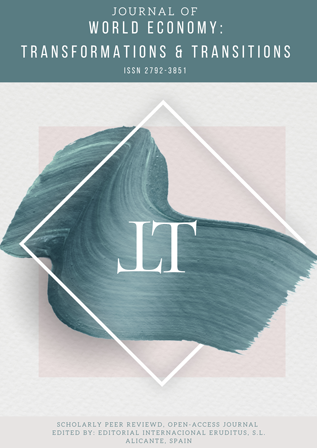The Impact of the Hockey-Stick Phenomenon on the Retail Industry in India: Pre and During COVID-19
DOI:
https://doi.org/10.52459/jowett24170922Keywords:
Hockey-stick phenomenon, Bullwhip Effect, Sales, India, COVID-19Abstract
The hockey-stick sales phenomenon has been less examined in the earlier studies and doesn’t receive much attention due to the cumbersome process involved in the change of sales policies in the companies and the overall restructuring of the supply chain management. The process is costly and mostly the hockey-stick sales phenomenon has an adverse impact on the profitability of companies. However, this was not observed in the case of the companies belonging to the retail industry in India. Our study shows that hockey-stick sales have a positive impact on the profitability of the companies measured by Profit After Tax (PAT) while on the other hand during the COVID-19 period, the hockey-stick sales phenomenon appears to impact negatively the profitability of the companies specifically. The results could not be generalized as the results are industry specific, but the methodology could be applied to a different industrial sector in order to study the relationship between hockey-stick sales and profitability and its impact on the performance of the companies.
CITE THIS PAPER:
Ahmed, Tooba; Ahmed, Salma; Naim, Hamza (2022). "The impact of the hockey-stick phenomenon on the retail industry in India: Pre and During COVID-19" Journal of World Economy: Transformations & Transitions (JOWETT) 2(04):17. DOI: https://doi.org/10.52459/jowett24170922
Metrics
References
Bradford L. Goldense., & Sticks, S. L. H. (2015). Do Your New Products Sell Like Hockey Sticks? Goldense on R&D-Product Development, January 2015. Available at: https://www.goldensegroupinc.com/CompPub/Articles/A102.pdf
Bradley, J. R., & Arntzen, B. C. (1999). The simultaneous planning of production, capacity, and inventory in seasonal demand environments. Operations Research, 47(6), 795-806. https://doi.org/10.1287/opre.47.6.795
Chen, H., Frank, M. Z., & Wu, O. Q. (2005). What actually happened to the inventories of American companies between 1981 and 2000? Management science, 51(7), 1015-1031. https://doi.org/10.1287/mnsc.1050.0368
Hines, P., & Taylor, D. (2000). Going lean. Cardiff, UK: Lean Enterprise Research Centre Cardiff Business School, 1, 528-534. Available at: https://leancompetency.org/wp-content/uploads/2015/09/Going-Lean.pdf
Hoberg, K., Badorf, F., & Lapp, L. (2017). The inverse hockey stick effect: an empirical investigation of the fiscal calendar’s impact on firm inventories. International Journal of Production Research, 55(16), 4601-4624. https://doi.org/10.1080/00207543.2016.1269969
Jerath, K., & Long, F. (2020). Multiperiod contracting and salesperson effort profiles: The optimality of “hockey stick,”“giving up,” and “resting on laurels”. Journal of Marketing Research, 57(2), 211-235. https://doi.org/10.1177/0022243719887378
Lee, H. L., Padmanabhan, V., & Whang, S. (2004). Comments on “Information distortion in a supply chain: The bullwhip effect”. Management science, 50(12_supplement), 1887-1893. https://doi.org/10.1287/mnsc.1040.0305
Lee, H. L., Padmanabhan, V., & Whang, S. (1997). Information distortion in a supply chain: The bullwhip effect. Management science, 43(4), 546-558. https://doi.org/10.1287/mnsc.43.4.546
Lorentz, H., Wong, C. Y., & Hilmola, O. P. (2007). Emerging distribution systems in Central and Eastern Europe: Implications from two case studies. International Journal of Physical Distribution & Logistics Management, Vol. 37 No. 8, pp. 670-697. https://doi.org/10.1108/09600030710825702
Neale, J. J., & Willems, S. P. (2009). Managing inventory in supply chains with nonstationary demand. Interfaces, 39(5), 388-399. https://doi.org/10.1287/inte.1090.0442
Nienhaus, J., Ziegenbein, A., & Schönsleben, P. (2006). How human behaviour amplifies the bullwhip effect. A study based on the beer distribution game online. Production Planning & Control, 17(6), 547-557. https://doi.org/10.1080/09537280600866587
Paik, S. & Bagchi, P.K. (2007), "Understanding the causes of the bullwhip effect in a supply chain", International Journal of Retail & Distribution Management, Vol. 35 No. 4, pp. 308-324. https://doi.org/10.1108/09590550710736229
Polite, B. N., Ratain, M. J., & Lichter, A. S. (2021). Oncology’s “hockey stick” moment for the cost of cancer drugs—the climate is about to change. JAMA oncology, 7(1), 25-26. https://doi.org/10.1001/jamaoncol.2020.1828
Sanches, L., & Lima, O. (2011). Hockey-stick phenomenon: supply chain challenges in Emerging countries. In the International Conference of the System Dynamics Society. Available at: https://proceedings.systemdynamics.org/2011/proceed/papers/P1134.pdf
Sanches, L. M., & Lima Jr. O. F. (2014). Hockey stick phenomenon: supply chain management challenge in Brazil. BAR-Brazilian Administration Review, 11, 264-283. https://doi.org/10.1590/1807-7692bar2014130044
Sohoni, M. G., Bassamboo, A., Chopra, S., Mohan, U., & Sendil, N. (2010). Threshold incentives over multiple periods and the sales hockey stick phenomenon. Naval Research Logistics (NRL), 57(6), 503-518. https://doi.org/10.1002/nav.20417
Zotteri, G. (2013). An empirical investigation on causes and effects of the Bullwhip-effect: Evidence from the personal care sector. International Journal of Production Economics, 143(2), 489-498. https://doi.org/10.1016/j.ijpe.2012.06.006
Downloads
Additional Files
Published
Issue
Section
License
Copyright (c) 2022 Tooba AHMED, Salma AHMED, Hamza NAIM

This work is licensed under a Creative Commons Attribution 4.0 International License.







